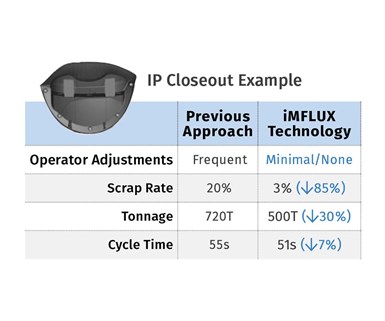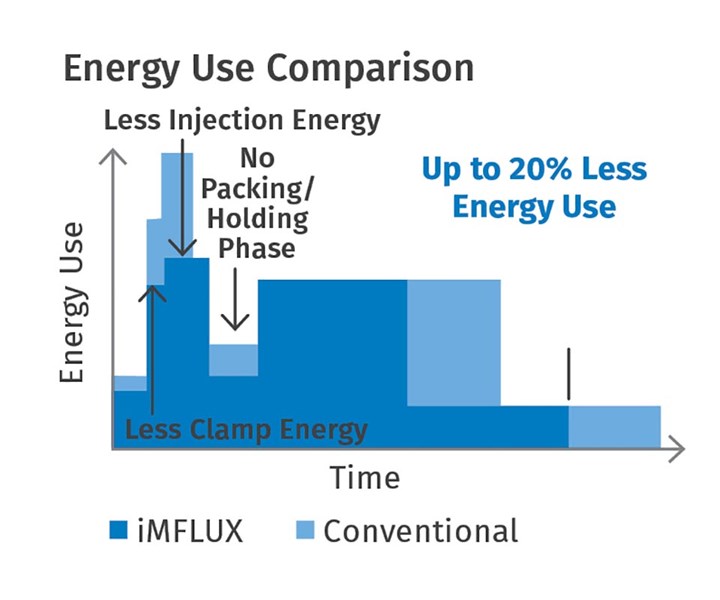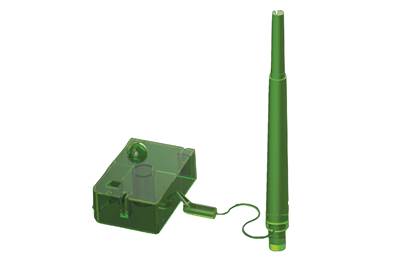Since the technology became broadly available in 2017, a growing number of injection molders have been learning how the iMFLUX low-pressure process can reduce both cycle times and reject rates, especially in tricky molding jobs. As the plastics industry embraces sustainability and the circular economy, iMFLUX technology offers an efficient tool to process recycled and biobased materials, use less energy, cut waste, and reduce part weight. This article will explain how this low-constant-pressure filling approach, and iMFLUX’s unique adaptive process innovations, can transform your operation and provide a smooth journey to a “circular” future. (Scroll down for basic facts about the process and FAQs.)

At Plastec West in February, iMFLUX and Wittmann Battenfeld demonstrated the ability of the constant-low-pressure system to correct in real time for large viscosity variations, such as occur with recycled materials. The SmartPower press equipped with iMFLUX control software and nozzle-pressure sensor switched between 6 and 55 MFI PP resins with no operator adjustment and “never made a bad part.”
The Challenge
Meeting the needs of a circular economy is no easy challenge, and most solutions come with significant tradeoffs for cost, quality, and operational complexity. Additionally, most solutions work only part of the time and address only a portion of the challenges. A solution is needed that delivers the necessary benefits and works with virtually any material, mold or molding machine—new or existing; hydraulic, electric or hybrid. This is where low-constant-pressure processing really shines.
Processing Recycled & Biobased Materials
iMFLUX enables running difficult and highly variable materials, such as post-consumer recycled plastics, without frequent operator adjustment and quality issues. Also, iMFLUX’s lower filling pressure and flow rates provide big advantages for running heat- and shear-sensitive materials, such as many bio-derived materials and fillers.
• Recycled materials: Many recycled streams are highly variable in viscosity and other characteristics, especially post-consumer recycled (PCR) materials. At iMFLUX, we are on a journey to truly autonomous operating processes, similar to cruise control in your car, whereby the controller detects changes in the molding system—such as material viscosity—and adapts the filling process in real time to compensate for these changes. The control system uses a single pressure sensor located in the machine nozzle as the primary control signal, then integrates other information such as the movement of the screw to create a continuous and real-time indication of the flow-front position and cavity pressure. This approach allows the system to detect and adapt to viscosity variations that are difficult, if not impossible, to detect with traditional molding processes. Importantly, this is all accomplished by adding one pressure sensor to the machine nozzle—there is no need for additional sensors in the mold.

FIG 1 iMFLUX Auto Viscosity Adjust adapts in real time to viscosity variations of 50 MFI or more.
iMFLUX’s latest Auto Viscosity Adjust (AVA) feature, a new artificial intelligence (AI) technology, enables the process to adapt to extreme viscosity variations in real time without operator adjustment. “If you can melt it, we can mold it” is how we sometimes describe how versatile AVA is when running highly variable material viscosity. The technology easily adapts to viscosity variations of 50 MFI points or more—even PCR streams rarely exceed this level of variability. Figure 1 shows how AVA adjusts the driving pressure upward for increased material viscosity, and downward for decreased material viscosity, thereby maintaining a consistent fill time.
iMFLUX and Wittmann Battenfeld teamed up at Plastec West in Anaheim, Calif., this past February to provide a live demonstration of how this AVA feature performs. The booth featured a Wittmann Battenfeld SmartPower 110 machine, a four-cavity dosing cup tool from iMFLUX, and a Wittmann robot and auxiliary equipment. The live demonstration switched back and forth between 6 and 55 MFI polypropylene materials—without operator adjustment. The Auto Viscosity Adjust process adapted in real time to this material transition, while simultaneously maintaining part quality and consistent part weights throughout the transition from one material to the other, which required from five to 20 shots, depending how much of the first material was left in the hopper when the second one was added. But the machine never made a bad part during the transition.
“This closed-loop processing technology combined with the accuracy and adjustment speed of our machine yielded amazing results with exceptional simplicity,” said Sonny Morneault, v.p. sales & marketing for Wittmann Battenfeld USA. Similar studies have been run across a range of part designs and materials with the same result: The technology recognizes material changes as they occur and immediately adjusts the process to compensate for these changes.
To illustrate just how impactful AVA can be in a real-world production environment, AGS Technology Inc. in Batavia, Ill., is an automotive custom molder using iMFLUX’s AVA technology to process raw recycled flake directly into high-precision molded parts. AGS uses a series of proprietary steps to clean the material, verify its performance, and then mold parts using specially outfitted JSW presses that include an intuitive iMFLUX integration solution.
The AGS approach has many advantages to lower cost, and it eliminates the step of re-extruding pellets, thus eliminating a heat history that degrades the material. However, there are operational challenges with this approach since, unlike traditional recycling, there is no re-extrusion step providing the opportunity to control viscosity through blending and other techniques. The raw recycled-material viscosity can vary widely batch-to-batch, and even shot-to-shot, which makes running these materials very challenging—the “acid test” of running highly variable recycled materials.

FIG 2 Automotive IP close-out had high scrap rates with recycled material until iMFLUX controls improved quality while reducing cycle time and press tonnage required.
AGS added iMFLUX processing software to their machines to manage this variation, and immediately realized reduced cycle time, reduced scrap, lower tonnage requirements, and importantly, eliminated the need for frequent operator adjustments. “Molding recycled engineering-grade polymers directly from regrind provides our customers tremendous value, but operationally it can be very challenging, with frequent operator intervention to maintain quality,” said George Staniulis, v.p. of AGS Technology. “Adding iMFLUX to our production cells has enabled our presses to run with less downtime and higher output. Quality has also improved, which frees up our operators to focus on higher value work.” Figure 2 shows a typical example of an instrument-panel close-out, where scrap levels were unacceptably high. iMFLUX was able to reduce scrap rates to a manageable level, reduced the required press size, reduced cycle time, and eliminated the need for frequent operator adjustment.

FIG 3 Shear gradient across the melt-flow channel is lower and more uniform with iMFLUX than with a conventional decoupled process.
• Shear & heat-sensitive biomaterials: Many bioderived and bio-composite materials are sensitive to high shear and heat. The use of low-constant-pressure filling results in a lower shear rate at the gate, and also reduces shear at high resistance points within the mold such as ribs, corners, undercuts, and living hinges. Figure 3 shows how the shear rate gradient is more uniform and lower than in a conventional decoupled process. Figure 4 shows a relative comparison of bulk shear rates in a dose cup part design, where shear is reduced at the gate and throughout the part. Furthermore, processing temperatures can be substantially reduced, and while filling pressure will increase slightly due to an increase in material viscosity it is still much lower than a traditional process. These characteristics of the low-constant-pressure process make it ideal for running shear and heat sensitive materials.

FIG 4 Simulation also shows reduced and more uniform shear throughout the part with iMFLUX.
Lower Energy Use
iMFLUX departs completely from the high-energy, high-shear, high-pressure traditional approach to injection molding, and thereby allows you to increase throughput and simultaneously reduce energy use. It comes down to less pressure, less work, and less heat equal less energy to mold a part. Energy consumption can be reduced by up to 20% or more, and these results can be obtained on any machine format—hydraulic, electric, or hybrid. Where do the energy savings come from?

FIG 5 Lower filling pressures and shear energy with iMFLUX greatly reduces energy consumption in molding.
• Filling energy is reduced up to 50%, since iMFLUX uses lower filling pressures and does not rely on high shear energy to fill the mold. Figure 5 shows how the energy to fill the mold is reduced, since the work required to fill the mold is lower than for a typical conventional decoupled process.

FIG 6 Lower filling pressures result in lower clamping energy with iMFLUX.
• Clamping energy is reduced by up to 50%, since lower filling pressures require lower clamp tonnage. Figure 6 illustrates this effect.

FIG 7 Faster cycles with iMFLUX also reduce energy use per part.
• Faster cycles spread energy losses over more parts, thus resulting in up to 20% lower energy use per part. Figure 7 shows how a shorter cycle time results in lower energy consumption relative to a conventional molding cycle.

FIG 8 Contribution of different factors to overall energy reduction in molding a 5-gal pail with iMFLUX.
To demonstrate iMFLUX’s energy saving potential, a study was conducted isolating filling, clamping, cycle time, and melt temperature. The results show that a low-constant-pressure process reduced energy by about 6.5%, and as additional energy-saving factors were added, a reduction of 17% was achieved. Figure 8 shows how each factor contributed to energy reduction. Similar studies have been run across a range of part types, sizes, materials, and press types, with results ranging to more than 20% total energy reduction. Energy savings in a production environment have ranged even higher when factors such as scrap reduction and the ability to run in smaller, more energy-efficient presses are included.
For Greystone, a manufacturer of transport packaging, energy savings was one of several advantages experienced with iMFLUX technology. “Running recycled and reprocessed materials is hard to do, often requiring frequent operator adjustments and dealing with higher scrap rates,” said Joe Carter, operations & maintenance manager. “iMFLUX adjusts the process, keeping parts consistent and in quality spec without operator time sitting at the monitor—all while avoiding scrap. An energy study showed we’ve been able to reduce our energy usage by a little over 30% on our large-tonnage presses.”
Reduce Part Weight
Add iMFLUX and immediately lower part weights 1-3%; design new parts with iMFLUX in mind and unlock the potential to lower part weights as much as 25% or more. In other words, activate iMFLUX on an existing mold and you typically achieve a 1-3% reduction in part weight, without any changes to the mold. But if you design new parts specifically for iMFLUX, you can reduce weights by 25% or more in many cases. There are two big reasons these weight reductions are possible: iMFLUX packs as it fills, and it uses lower molding pressures.

FIG 9 “Packing as it fills” helps iMFLUX reduce cycle times by eliminating a separate packing phase.
By filling slower and at a low, constant pressure with iMFLUX, the polymer densifies/packs as the mold fills. Most of the part is frozen before the flow front reaches the end of fill, so when the mold is full the part is already completely packed. Unlike a traditional decoupled molding process, there is no need for a holding phase to force more material into the mold, and the result is a 1-3% reduction in part weight. Importantly, the process provides these benefits in your existing mold—there is no need for mold modifications. Figure 9 illustrates how filling at low, constant pressure results in a much thicker frozen fraction throughout the mold—the part is “packed as it fills.” This is also a key to faster cycles.

FIG 10 Lower cavity pressures with iMFLUX can facilitate thinner walls and lightweighting.
Added Lightweighting Potential
It is no secret that if you can lower filling pressures, then you can make thinner parts. iMFLUX provides up to 50% or more reduction in filling pressures, opening up substantial thin-walling potential. It is also no secret that thinwall applications require getting the material into the mold without hesitation, or the material will freeze off very quickly and result in part defects. iMFLUX is a single-phase (no velocity-pressure transfer) process that never hesitates. This combination of lower molding pressure and hesitation-free polymer flow provide the potential to reduce part weights by up to 25% or more. Figure 10 illustrates how cavity pressures are reduced with the iMFLUX process; this lower pressure can be “re-invested” to reduce the nominal wall thickness and reduce part weight.
Related Content
What to Look for in High-Speed Automation for Pipette Production
Automation is a must-have for molders of pipettes. Make sure your supplier provides assurances of throughput and output, manpower utilization, floor space consumption and payback period.
Read MoreHow to Optimize Injection Molding of PHA and PHA/PLA Blends
Here are processing guidelines aimed at both getting the PHA resin into the process without degrading it, and reducing residence time at melt temperatures.
Read More‘Monomaterial’ Trend in Packaging and Beyond Will Only Thrive
In terms of sustainability measures, monomaterial structures are already making good headway and will evolve even further.
Read MoreMedical Tubing: Use Simulation to Troubleshoot, Optimize Processing & Dies
Extrusion simulations can be useful in anticipating issues and running “what-if” scenarios to size extruders and design dies for extrusion projects. It should be used at early stages of any project to avoid trial and error and remaking tooling.
Read MoreRead Next
Moving Toward ‘Autonomous Molding’ with a Uniform-Low-Pressure Process
A new low-pressure injection molding process has aroused interest among molders and machine suppliers. In his second article on iMFLUX, the inventor of the process explains how it is evolving to support the overall industry goal of self-correcting molding processes that can compensate for common causes of variation to maintain consistent part quality.
Read MoreHeadlines from Fakuma 2018
Integrating a special low-pressure process into machine controls; novel shop-floor quality-inspection technology; MES systems from machine and controls vendors; and sophisticated in-mold decorating.
Read MoreA New Way to Mold Better Parts Faster and Easier
A new injection molding process ‘breaks all the rules’ by using low, constant pressure to achieve faster cycles and better-quality parts.
Read More
































